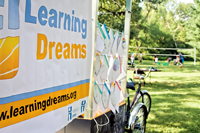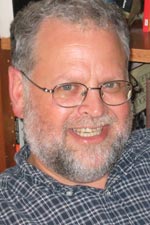Andre came into the library after school. What he wanted to know, he said, was how to make his own archery bow.
 The reply went beyond the call number for a book. As it happens, a craftsman in the neighborhood makes bows. A few weeks later, Andre (not his real name) was working beside Riley Harrison at the Hack Factory, making his dream come true.
The reply went beyond the call number for a book. As it happens, a craftsman in the neighborhood makes bows. A few weeks later, Andre (not his real name) was working beside Riley Harrison at the Hack Factory, making his dream come true.
Such connections are the magic of Learning Dreams. At the library, Andre talked to a librarian who sent him to a Learning Dreams staff member. Learning Dreams located the craftsman and engaged Andre’s mother, who checked out the craftsman and gave her okay. Along the way, Andre’s mom got the chance to talk about her own learning dreams.
Learning Dreams is a concept or approach more than a program. It focuses on connecting families with the whole local learning ecosystem beyond schools–community centers, libraries, museums, businesses, employment centers and more. Now nearing its twentieth year, Learning Dreams continues to evolve, shape-shifting to meet current needs and opportunities.
Its latest collaboration is with Hennepin County Library. As libraries everywhere are changing, they are becoming curators of learning as well as books. In Hennepin County, they are putting “learning-dreams thinking” to work to create a vision of things to come.
“We’re meeting more parents,” says East Lake librarian Katherine Debertin. “Andre has been coming to the library for a long time, but now he brought his mom to meet me–he said, ‘I want everybody to know each other!'”
The initial focus at the East Lake library was to engage Learning Dreams to strengthen the Homework Hub program. Parents have turned out to be a big part of the equation.
“Parents are children’s best and first teachers, and they are at least as critical to school success and graduation as getting homework done,” says division manager Ali Turner of Hennepin County Library. “Learning Dreams is a new way for us to engage families in the learning process and support them in support of their children’s school success.”
Debertin says Learning Dreams also helps her staff respond to the neighborhood more spontaneously. A book club formed for Somali-born parents who want to learn English. One girl’s interest in cooking led to a connection with a chef; suddenly the library had 12 young people showing up for a cooking class that lasted several weeks.
Knowledge in neighborhoods
 Jerry Stein developed learning-dreams thinking in the 1990s when he was asked to help design a tutoring program for kids in a public housing community.
Jerry Stein developed learning-dreams thinking in the 1990s when he was asked to help design a tutoring program for kids in a public housing community.
“I had this realization,” he remembers. “I told the group that if the kids’ families and communities love learning, it will work…otherwise it’s a waste of time. So, then the question becomes, ‘What do people love learning about, or what would they love learning about if they had the chance?'”
Stein had written his dissertation on the U.S. philosopher and educator John Dewey (1859-1952). Dewey is best known for creative school innovation, but he changed course late in life to focus on the “educative community.” Stein began to focus on the educative community of the families he was working with. He ended up developing a program called Neighborhoods Educating Themselves, or NET.
“It was not the best name,” Stein chuckles, shaking his head. “The question we asked when we went out to visit people was, ‘What’s your learning dream?’ That did it. That got people interested and thinking. It just took me awhile to realize that Learning Dreams was the real name and then change it.”
The results of the first project were hopeful. While working with a small group of parents to identify and pursue their own learning dreams, all got involved in their neighborhood school. Meanwhile, the truancy rate of their children fell to zero and their academic performance improved.
Dreams on the move
The learning-dreams approach “takes sole,” Stein has punned for years. By that he means the soles of his and many other feet hitting the pavement, going out to meet and talk to people in their neighborhoods and homes.
The history of social work cannot be told without including settlement houses, bricks-and-mortar centers built in the late 1800s and early 1900s in poverty-stricken urban neighborhoods, where people could access the assistance they needed. A dream of Stein’s was to create an “unsettlement house” that would make those resources mobile.
When Stein met Jack Becker from Forecast Public Art, the Unsettlement House became a reality. It was a trailer that could be pulled by a vehicle, equipped with Learning Dreams supplies for staff and volunteers wherever the trailer parked.
Next came the Dreamcycle, a nimbler trike-powered kiosk that can meet people almost anywhere–on street corners, in parks, at fairs, outside libraries. In 2012 it spent time at the Minnesota State Fair, then appeared in the Hennepin County Government Center in conjunction with a month-long exhibit. Passersby stop to talk to a Learning Dreams volunteer and fill out colorful cards that say, “I want to learn . . .” followed by a cloud-shaped space. Anybody who fills out a card gets a follow-up call or email, often the same day, with information about places to learn their dream, from yoga to playing the flute to learning to drive, near their home or neighborhood.
Learning Dreams continues to make its way around the state. It spent two years in Worthington and more recently two years in St. Paul, collecting people’s learning dreams and helping them find local, accessible resources to make those dreams come true. It has partners as far as Belfast, Ireland. It can be applied or adapted anywhere. Now Stein is excited about the potential of the library partnership, especially as results from the first year roll in.
“Libraries are one of our nation’s most revered systems of learning,” he says. “The library system can be as instrumental in transforming learning now as it did in its earliest charter. Learning Dreams and the libraries share similar missions and fundamental purposes. Everybody who cares about learning cares about libraries.”
The slogan of the new partnership is “Bring your dreams to the library!” At the same time, libraries are learning how to bring library thinking out into the community. Learning Dreams staff can show families how they have immediate and direct online access to library staff through Ask Us–the app and text access are available to anyone.
“You can really ask just about any question of the library and we at least know where to get started or who to call,” says Turner.
Libraries dream, too
Now the partnership has got the librarians exploring their own learning dreams. When East Lake began putting Learning Dreams to work on its Homework Hub program, everybody in the library got involved.
“Learning Dreams work included all of us, not one or two people on the staff,” says Debertin. “We’re all part of this together.”
That includes volunteers, Turner adds.
“Our work with Learning Dreams has provided a unique way for volunteers, tutors, and staff to tap into their own learning dreams,” she says. “It gives us all fresh empathy for that tingly feeling of curiosity and wanting to learn something new. It has transformed our collective approach to welcoming and supporting students!”
Story by Gayla Marty | Photos courtesy of Learning Dreams | Spring 2013



